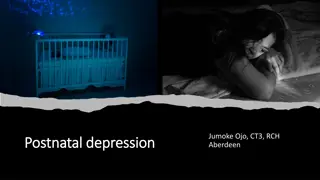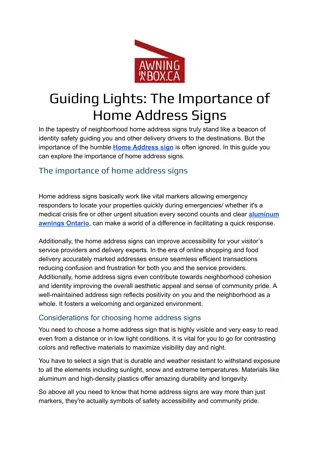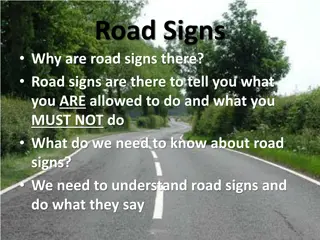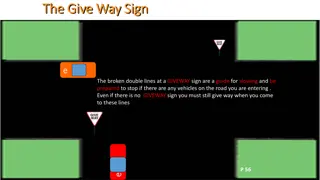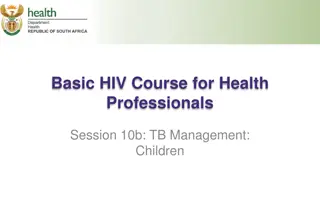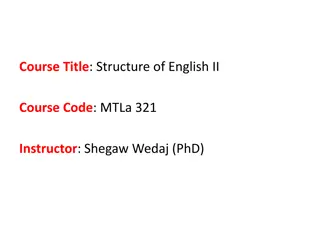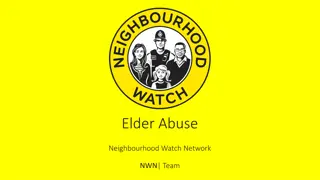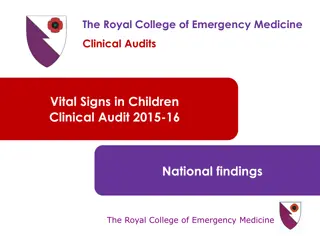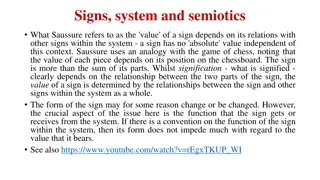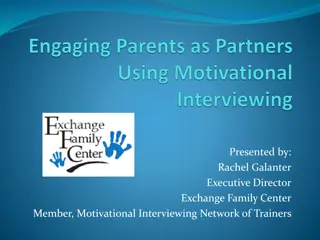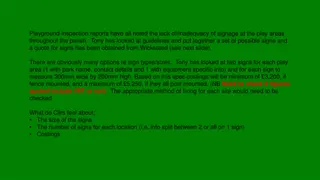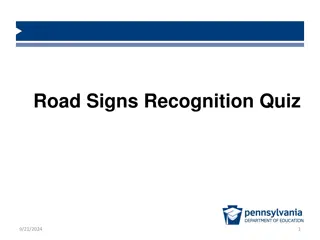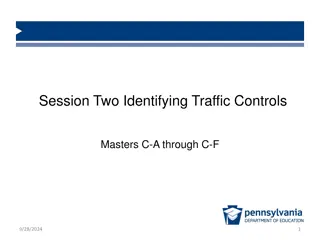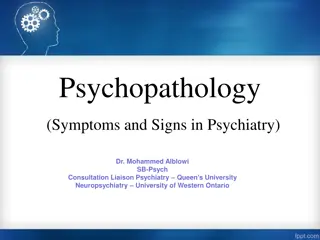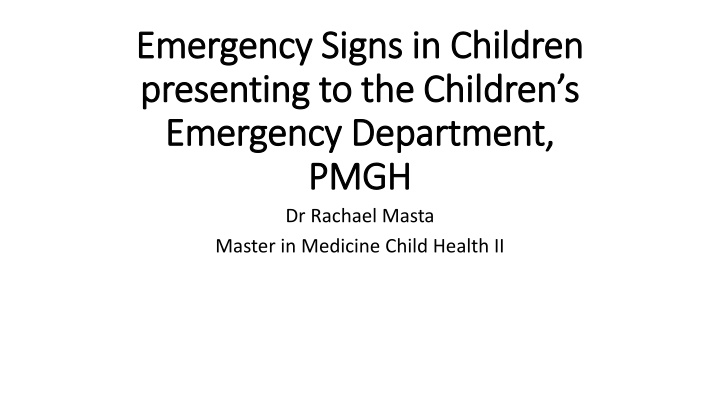
Identification and Management of Emergency Signs in Children at PMGH
Explore the study focusing on emergency signs in pediatric patients at the Children's Emergency Department in Port Moresby General Hospital. The research aims to identify, analyze, and document specific danger signs, along with examining triage nurse assessments and patient outcomes related to these signs.
Download Presentation

Please find below an Image/Link to download the presentation.
The content on the website is provided AS IS for your information and personal use only. It may not be sold, licensed, or shared on other websites without obtaining consent from the author. If you encounter any issues during the download, it is possible that the publisher has removed the file from their server.
You are allowed to download the files provided on this website for personal or commercial use, subject to the condition that they are used lawfully. All files are the property of their respective owners.
The content on the website is provided AS IS for your information and personal use only. It may not be sold, licensed, or shared on other websites without obtaining consent from the author.
E N D
Presentation Transcript
Emergency Signs in Children Emergency Signs in Children presenting to the Children s presenting to the Children s Emergency Department, Emergency Department, PMGH PMGH Dr Rachael Masta Master in Medicine Child Health II
Introduction Introduction Children's Emergency Departments (CEDs) is the first point of contact for children with serious illnesses or injuries In 2022, the Children's Emergency Department at Port Moresby General Hospital (PMGH) attended to over 17,000 children from areas within the National Capital District, Central, and Gulf Provinces. A total of 6355 patients were attended to at the CED in the second quarter of 2023 with 88% of attendees seeking primary health care 2. 2Paediatric Department 2022 Annual Report
The WHO Pocket book of Hospital Care for Children outlines the identification and management of Emergency signs in sick children. These signs include obstructed or absent breathing, severe respiratory distress, central cyanosis, signs of shock, coma, convulsions, and signs of dehydration8 Knowledge of basic working techniques and typical clinical signs enables the physician to proceed with confidence when treating pediatric emergencies 8World Health Organization (2013). Pocket book of hospital care for children
Aim Aim The aim of this study is to identify and document the specific danger signs present in children attending the Children's Emergency Department (CED) at Port Moresby General Hospital (PMGH)
Objectives Objectives Systematically record and analyze the types and frequencies of emergency signs observed in pediatric patients, and assess the agreement between triage nurses assessment of emergency signs and the assessment of a Paediatric medical officer Investigate the underlying conditions associated with the identified emergency signs in children attending the CED Examine the relationship between emergency signs and patient outcomes, such as hospital admission, referrals, or discharge, to understand the impact of these signs on patient management and outcomes.
Methods Methods Study Site Port Moresby General Hospital, Children s Emergency Department Study type and duration Prospective observational study 3 months: February to April 2023
Methods Methods Inclusion Criteria Age between 0 and 12 years presenting to CED and seen at triage No preexisting chronic conditions Consent from parents or guardians
Methods Methods Data were collected at two points - 1stat triage by nursing staff - 2ndat the screening table by Medical Officers Information on individual patients demographics, presenting complaints, vitals signs, presence or absence of WHO outlined Emergency Signs and disposition were collected at these points with the following forms Triage form Data Collection
Total patients recruited n = 204 Results Results Excluded >12 years Pre-existing conditions > 12 with pre-existing condition 3 2 7 Total= 12 n = 192 patients included Emergency signs identified n = 32
Gender Age Groups 100 88 80 41% 65 60 39 40 59% 20 0 less than 12 months 12-60 months more than 60 months Male Female
Results Results Freq. Point Prevalence No emergency signs 160 83.3 Emergency signs 32 16.7 Convulsions 3 1.6 Mixed 1 0.5 Severe dehydration 10 5.5 Severe respiratory distress 18 9.4
Inter-rater agreement Inter-rater agreement is assessed by the kappa statistic: kappa of >0.4 is often taken as acceptable inter-rater agreement, although the higher the kappa the better the agreement between assessors. High inter-rater reliability (>0.6) Sunken eyes and poor conscious state had the best inter-rater reliability Moderate inter-rater reliability (0.4-0.6) subcostal recession, intercostal recession, nasal flaring, lethargy, weak volume pulses, and convulsions. Poor inter-rater agreement (<0.4) Obstructed breathing, cyanosis, tracheal tug and cold hands and feet were less commonly detected and had poor inter-rater agreement
Sign Identified by nurses at Triage Identified by doctor assessor Kappa Sunken eyes 10 / 192 11 / 192 0.75 Poor conscious state 3 / 192 3 / 192 0.66 Intercostal recession 16 / 192 8 / 192 0.56 Nasal flaring 4 / 191 7 / 192 0.53 Weak volume pulse 1 / 192 3 / 192 0.50 Convulsions 2 / 192 2 / 192 0.50 Subcostal recession 11 / 192 17 / 192 0.46 Lethargic 4 / 192 9 / 192 0.45 Cold hands and feet 6 / 192 1 / 192 0.28 Tracheal tug 4 / 192 13 / 192 0.21 Slow skin pinch 0 / 192 3 / 192 0.0 Obstructed breathing 1 / 192 0 / 192 0.0 Cyanosis 0 / 192 1/192 0.0 Prolonged capillary refill >3 sec 0 / 192 0 / 192
Discussion Discussion 32 children out of the 192 (16.7%) assessed that had emergency signs at presentation. Of these 18 (9.4%) had severe respiratory distress, 10 (5.2%) had severe dehydration, and 3 (1.6%) had convulsions. Some signs were well identified by triage nurses, while some, including tracheal tug and nasal flaring were less well recognised. Nurses detected more children with cold hands and feet than medical officers. 2 assessments were some minutes apart, so it is possible that some signs, such as cold peripheries and intercostal recession were identified and treated by nursing staff by the time of the 2nd assessment
Limitations Limitations Small sample size Recruitment only took place when there was availability of nurses for triaging Observational bias
Conclusion Conclusion The study has shown the use of a quick but thorough check list as taught in the WHO Pocketbook of Hospital Care for Children is effective in screening children at the Emergency Department Effective screening at triage can enable prompt emergency treatment to be given by nurses, and help doctors focus attention on children who require it most. More training in the identification of some signs that are often missed. Resources put an effective triaging system will assist with fast effective management of severely ill children.
Acknowledgements Acknowledgements Professor Trevor Duke (Supervisor) Dr Merlissa Kuama, Dr Rhondi Kauna & Dr Ruth Badia (co- researchers) Paediatric Department - PMGH CED Nursing Team My family All the patients who took part in my study
References References 1. 2. 3. Anga, G. (2023). Paediatric Department Quarter 2 Report 2023. Anga, G. (2023). Paediatric Department Annual Report 2022. Ngwalangwa, F. et al.(2019) Risk factors for mortality in severely ill children admitted to a tertiary referral hospital in Malawi , The American Journal of Tropical Medicine and Hygiene, 101(3), pp. 670 675. doi:10.4269/ajtmh.19-0127. Thunberg, A. et al.(2022) Hypoxemia, hypoglycemia and IMCI danger signs in pediatric outpatients in Malawi , PLOS Global Public Health, 2(4). doi:10.1371/journal.pgph.0000284. Deutscher rzteverlag GmbH, R.D. . (2009) Principles of Pediatric Emergency Care (06.11.2009), Deutsches. Available at: https://doi.org/10.3238/arztebl.2009.0739 (Accessed: 13 August 2023). Bult, G.A. et al.(2019) Knowledge of neonatal danger signs, care seeking practice and associated factors among postpartum mothers at public health facilities in Ambo Town, Central Ethiopia , BMC Research Notes, 12(1). doi:10.1186/s13104-019-4583-7. Kalisa, Michael; 2013.Risk Factors Associated with Presence of General Danger Signs in Children Who Present with Acute Severe Illness at Kenyatta National Hospital World Health Organization (2013). Pocket book of hospital care for children : guidelines for the management of common illnesses. Geneva: World Health Organization. 4. 5. 6. 7. 8.

